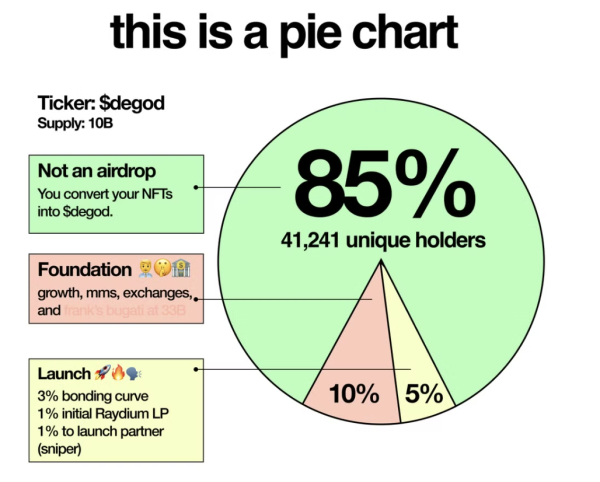$degod is a new token in the Solana ecosystem, aiming to combine the three major NFT project assets of DeGods , y00ts and $dust to provide a simpler and more intuitive way of use. $degod attempts to use newly issued tokens to bind the value of NFT and tokens in a vertical and horizontal way. Will this trick work?
Table of Contents
ToggleWhat is $degod?
$degod is a new token on the Solana blockchain with a total supply of 10 billion. DeGods, y00ts and $dust These NFT projects and their token assets can be converted into $degod, providing users with a unified form of digital assets.

How does the conversion mechanism work?
Each NFT or $dust can be converted into $degod for a fixed amount. It is worth noting that when you exchange DeGod NFT for $degod, you need to pay a 3.33% royalty fee, which has become a key source of income in the operation of the project.
Token Distribution and Economics
The most natural token distribution ever?
$degod says its distribution has happened organically over the past three years without people realizing it. There are 41,241 holders from DeGods, y00ts and $dust spread across four different blockchains, with the top ten holders only accounting for about 9.3% of the total supply. This distribution method makes $degod possibly one of the most natural token distributions in history.
Of course, this is just a statement. Before cooperation, their holders will indeed be dispersed to a certain extent.
Issuance and trading of $degod
How to conduct a token issuance?
$degod will sell 3% of $degod in a discount curve to provide seed funding for liquidity. Once this discount curve is filled, a liquidity pool will be launched on Raydium, at which time $degod will be able to trade freely.
Participation methods and limits
In the early stages of the issuance, users can purchase up to 33.3 SOL (approximately equal to 1 DeGod) of $degod, providing investors with an opportunity to get started.
Holder-optional conversion: Do I have to convert to $degod?
Freedom of choice: Conversion is not the only option
Holders are not required to convert their NFT or $dust into $degod. In fact, refusing to switch is seen as a form of support for the community. Holding an NFT is equivalent to removing the token from the market, thus forming the basis for rarity and value growth.
$degod’s conversion process and future development
How is conversion rate determined?
The conversion rate is determined based on the market capitalization ratio of each asset in the past 6 months. Specifically, DeGods accounts for 65%, y00ts accounts for 21%, and $dust accounts for 14%. This design simplifies the conversion process and avoids complex formula calculations and disputes.

Where does the NFT go after conversion?
y00ts and $dust tokens will be destroyed, and DeGods will enter a market called the "floor pool". Users can use SOL, $degod, or even exchange other DeGods to purchase DeGod NFTs in the pool. These DeGods will dynamically adjust their prices based on the price of $degod.
$degod represents an innovative attempt to integrate three major asset projects to provide users with more flexible operating space. Whether choosing to hold NFTs or convert to $degod, the ecosystem provides investors with diverse options.
Innovation or mutual support?
Gordon Goner, co-founder of BAYC, commented : "I don't know if the DeGods' move will work in the long term (almost no one does), and I wouldn't do it for BAYC, but it's really fun to watch this project try crazy things. It's It's obviously worth it."
DeGods is not the first to use this strategy of bundling interests to seek a future together. Cryptocurrency AI newcomers have also begun to look for new solutions after the critical acclaim of ChatGPT. SingularityNET, Fetch.ai and Ocean have agreed to join forces to focus on AI development and have also promised to issue new tokens, but they still exist separately. However, the merger of DeGods is a marriage project. This move may be seen as an attempt to reduce circulation pressure and jointly push up the value of the new currency.







